Home » Eocene
Category Archives: Eocene
Geosciences, Volume 15, Issue 3 (March 2025)
The march issue of the Geoscience journas has a cover story dealing with the newly published paper in that issue by Tosquella et al. (2025) of our group. In the Betic-Rif Cordilleras the Eocene platforms started in the Cuisian after a gap including the Ilerdian. An Eocene succession with gravity flows consisting of turbidites and olistostromes was detected in the Aspe-Terreros Prebetic section (External Betic Zone). In one of the turbidites, we dated the middle Ilerdian, on the basis of LBF, representing a vestige of a missing Illerdian carbonate platform. The microfacies of these deposits rich in LBF have been described and documented. The gap in the sedimentation and absence of Ilerdian platforms in the Betic-Rif have been related to the so-called Eo-Alpine tectonics (Cretaceous to Paleogene) and sea-level variations contemporarily with the establishment of shallow marine realms in the western Tethys.
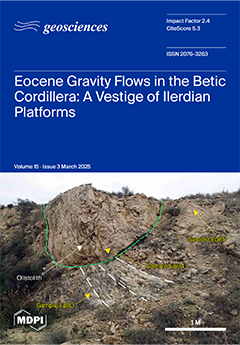
Paleocene-Eocene evolution of the Prebetics (South Spain) and comparison with other western Tethyan margins
Thirteen Paleocene-Eocene sections have been studied along the Prebetic Domain (South Iberian Margin) in the Alicante, Murcia, Granada, and Jaen Sectors. The sedimentary realms (mostly consisting in 15 shallow marine Lithofacies) and the tectono-sedimentary evolution were characterized. Three informal stratigraphic units were proposed and dated with planktic foraminifera, calcareous nannoplankton, and Larger Benthic Foraminifera (LBF): (1) lower marly-clayey fm; (2) intermediate limestone-calcarenite fm; and (3) upper marly-clayey fm. The stratigraphic architecture shows diachronous boundaries and lateral passages, representing the internal and external platform (upper slope in a few cases). The lower marly-clayey fm is upper Paleocene to middle Lutetian, the intermediate limestone-calcarenite fm ranges from lower Ypresian to lower Bartonian, while the upper marly-clayey formation is lower Lutetian to lower Priabonian. The diachronism can be due to the inherent sedimentary paleoenvironment changes and to climatic-tectonic interferences. The noticeable thickness variations of sedimentary successions in the studied sections could indicate a synsedimentary tectonics with upward and downward movements of blocks or folds. During the Paleocene-Eocene, the studied area was part of the meridional belt of platforms in the western Tethys. A comparison with other sectors of the central-western Mediterranean area has been performed to evidence synchronous events at Tethyan scale. The compared margins experienced a common pre-foredeep evolution affected by the Eo-Alpine tectonics (Cretaceous to Paleogene) contemporaneously to the establishment of shallow and deep palaeoecological realms. In the case of shallow sedimentary successions, LBF and corals are registered. Comparable gaps in sedimentation are recorded in most of the correlated domains.
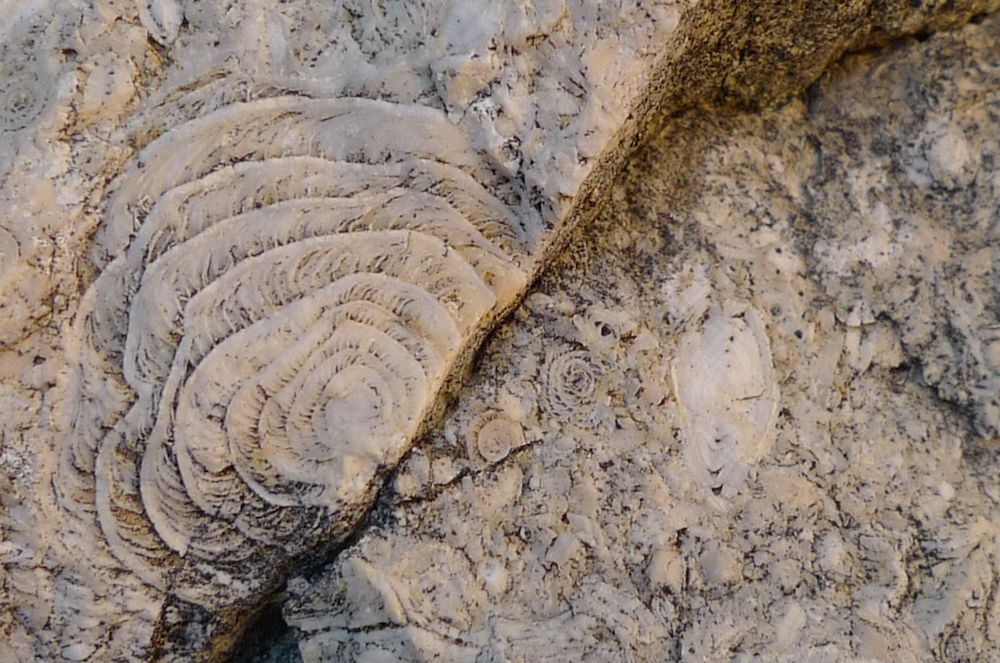
The Eocene carbonate platforms of the westernmost Tethys: a review
According to the prevailing view in literature, two Eocene carbonate platform belts developed on northern and southern margins of the Tethys Ocean. However, Eocene platforms in the Malaguide −Ghomaride Units (Betic-Rifian Arc; Spain and Morocco, respectively) in intermediate position to the classic platform belts have been proposed in recent literature. A number of representative Ypresian to Priabonian stratigraphic sections have been revisited and empowered by new data collected for the scope. Ten lithobiofacies (consisting of limestones rich in Larger Benthic Foraminifera (LBF), algae, and corals) and ten microfacies (based on fossil assemblage and their relative abundance, texture, and fabric) were proposed for this intermediate platform belt. The paleoenvironmental reconstruction indicate inner to outer ramps (locally also the upper slope) arranged in two sedimentary sequences rich in LBF and corals. A great development of carbonate seagrass factories in most of the areas in which inner ramps developed has been identified. These factories correspond to a warm-temperate system with warm-water conditions mainly in low latitude settings. Trophic resources proposed in these works suggest oligo- to mesotrophic conditions in inner to mid ramp settings, which only evolve to eutrophic conditions in outer ramp and upper bathyal settings. A comparison of the three belts of carbonate platforms at the western Tethys scale has been performed, providing several important constraints in terms of the recorded time period according to the literature, tectonics, transgressive−regressive trendings, relative abundance of fossils, and paleoenvironmental conditions.
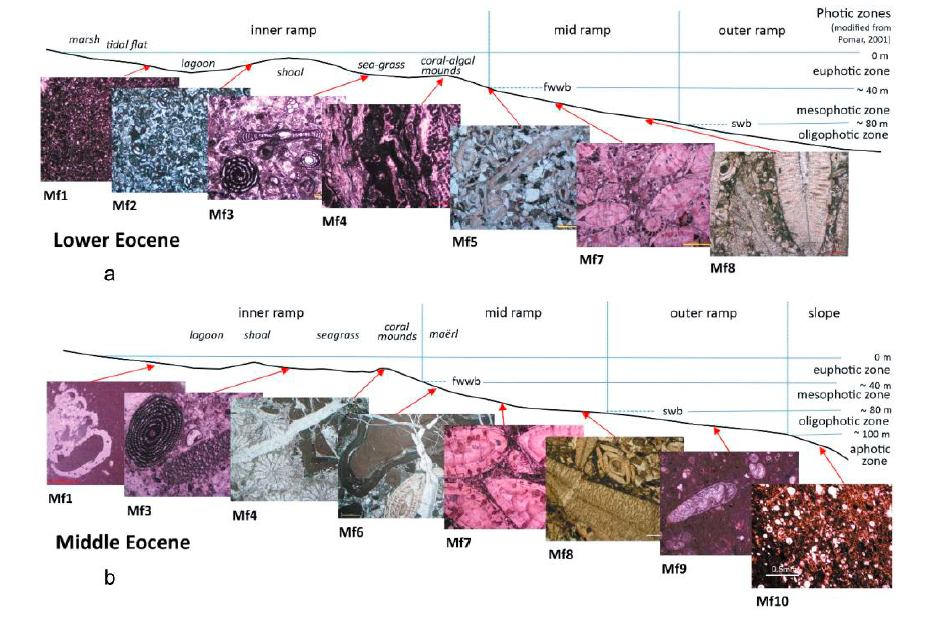
Environmental microfacies distribution for the Eocene marine Malaguide−Ghomaride Domains (modified from Maaté et al. 2000; Martín-Martín et al. 2020, 2021, 2023c; Tosquella et al. 2022). Ramp subdivision is based on Burchette and Wright (1992), while photic zones are modified from Pomar (2001); the new considered ‘mesophotic zone’ (zonation by Hottinger 1997) lies between the lower limit of occurrence of marine vegetation and the last occurrence of Larger Benthic Foraminifera, approximately coinciding with the storm wave base (swb). Key: Mf1, inner ramp lagoon, upper subtidal environment; Mf2, shoal, upper subtidal environment; Mf3, inner ramp seagrass, euphotic upper subtidal environment; Mf4, inner ramp coral-foralgal and acervulinid mounds, euphotic environment; Mf5, transgressive lag deposits in the transition between inner-to-mid ramp, euphotic to mesophotic environment; Mf6, mid ramp foralgal packstone–rudstone, mesophotic ma.rl environment; Mf7, proximal mid ramp LBF accumulations (nummulitids) in a mesophotic environment; Mf8, distal mid ramp LBF accumulations (orthophragminids) in a mesophotic to oligophotic environment; Mf9, outer ramp, oligophotic environment; Mf10, aphotic slope environment.
The Eocene platforms of the westernmost Tethys show a lacunose geological record registered from upper Ypresian (Cuisian) to Bartonian. It shows an important gap at the upper Ypresian (Cuisian)−Lutetian boundary. LBF remained the primary framework builders elsewhere until the Bartonian age, with zooxanthelle−coral build-ups playing a more significant role in the inner ramps than previously assumed.
Cite as: Martín-Martín, M., Tosquella, J., Guerrera, F., Maaté, A., and Martín-Algarra, A. (2024). The Eocene carbonate platforms of the westernmost Tethys: a review. International Geology Review, 1-33. https://doi.org/10.1080/00206814.2024.2397804
Spanish Geological Congress in Avila
A paper on geological cycles during the Eocene in the Prebetic (SE Spain) was presented at the XI Spanish Geological Congress held Ávila (Spain) from July 1 to 6, 2024. The picture show the poster and the participant José Enrique Tent-Manclús.
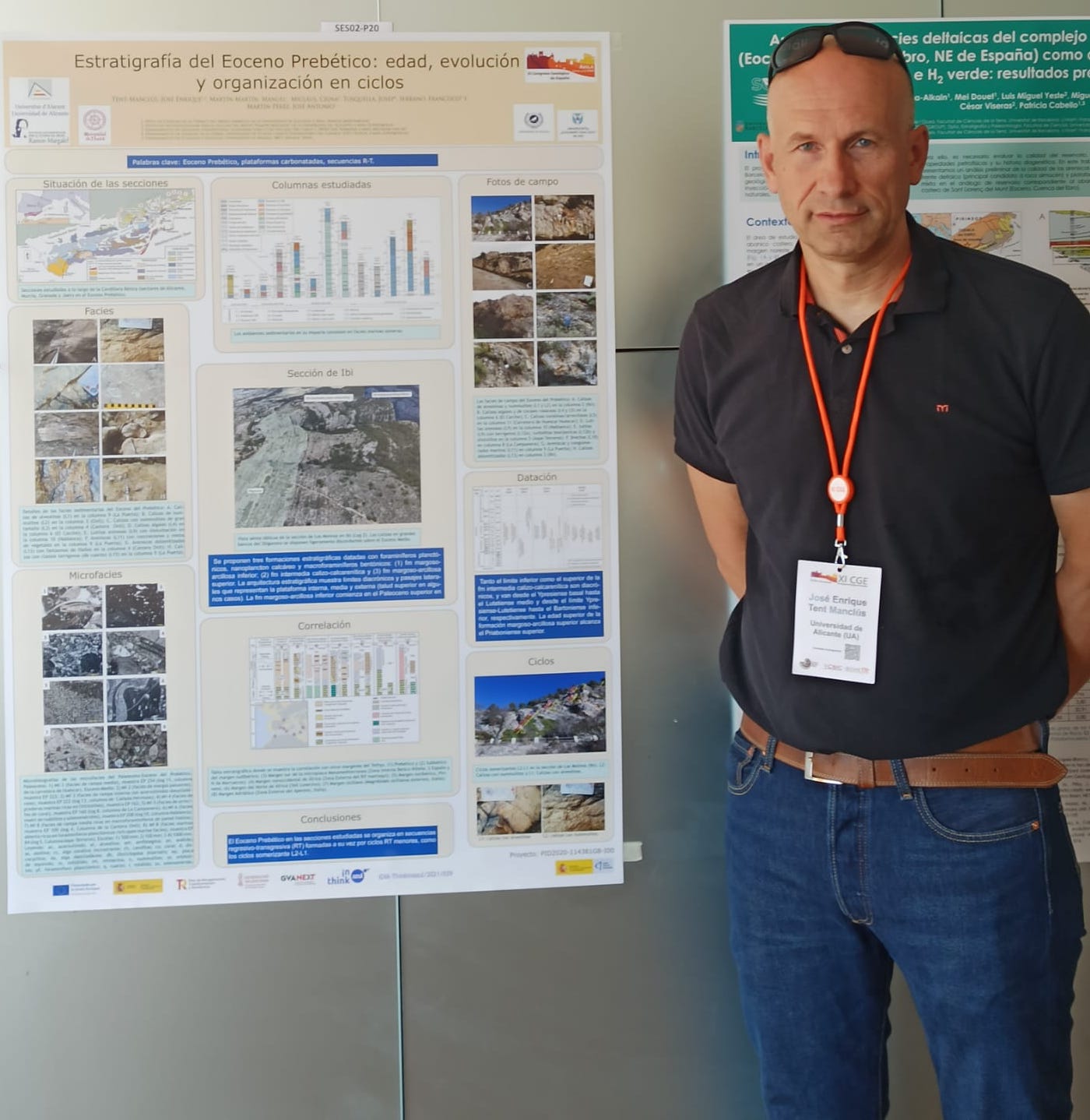
Field trip in Morocco: Searching for the Nummulites
The Africa call…
Well the third field work campaign the project. This time in the Middle Atlas of Morocco. The objetive was to find Nummulites as the ones in the Betic or in the Rif.
The picture shows the members of the team. Picture taken by Soufian Maaté.
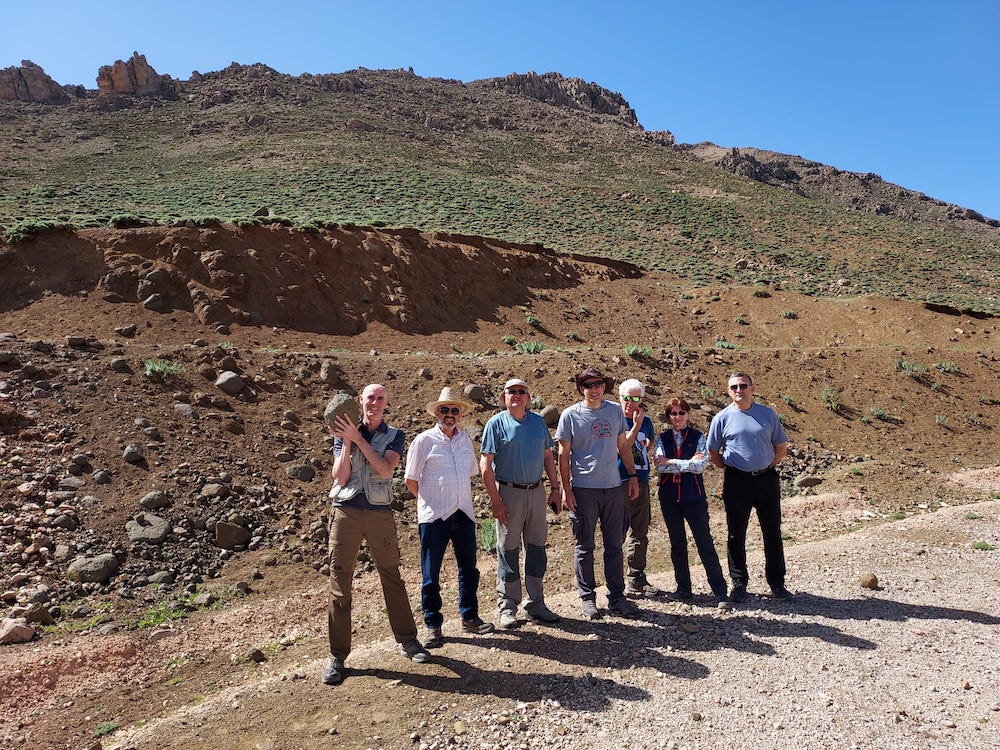
Manuel Bullejos Lorenzo (Granada University)
Rachid Hlila (Abdelmalek Essaádi University)
Ali Maaté (Abdelmalek Essaádi University)
Manuel Martín-Martín (Alicante University)
Soufian Maaté (Moulay Ismail Errachidia University)
Crina Miclăuș (Alexandru Ioan Cuza University)
José Enrique Tent-Manclús (Alicante University)
And the collaborators:
Pedro Robles (Alicante University)
Santiago Moliner (Alicante University).
After a week (from April 23rd until April 30 2023). Many rock samples were taken and we did not find them but our hope is to look carefully the thin sections for tiny Nummulites.
This is the third major field trip of the project of the Spanish research agency (Agencia Estatal de Investigación) of the Spanish Science and innovation minister (Ministerio de Ciencia e Innovación) entitle as “EVOLUCION TECTONO-DEPOSICIONAL DE CUENCAS SEDIMENTARIAS CENOZOICAS: CARACTERIZACION 2D-3D Y MEJORA DE PATRONES ESTANDAR” (PID2020-114381GB-I00). See previous post.
Small scale RT cycles in Prebetic Lower-Middle Eocene (Alicante)
In the study of the Alicante External Prebetic Eocene platforms, ten sedimentary facies were defined in field based on lithology and fossil content observed, as follows: L1 – limestone (lmst.) with Alveolina; L2 – lmst. with small Nummulites (< 3 cm diameter); L3 – lmst. with big Nummulites (>3 cm diameter); L4 – algal lmst.; L5 – lmst. with miliolids; L6 – micritic lmst. with gastropods and bivalves; L7 – marls; L8 – greenish siltstones; L9 – dolomitized lmst. and/or dolostone; L10 – sandy lmst.
The lower interval of the Ibi section twelve L2-L1 units were defined, after which the first dolomitized limestone (L9) occurs, changing the motif to L2-L1-L9 or L1-L9. The middle part of the succession is marked by the occurrence of facies L10, while the upper part by five units with L5-L7.
The lower interval of the Ibi section, consists of thinning-upward units, each one showing a shallowing-upward trend, indicating a decrease of accommodation in middle ramp area, ended with the basinward shift of the proximal open inner ramp. The upper interval, consisting in thickening-upward units, sedimented in lagoon-shoals of inner ramp, indicates increasing of accommodation. This interval is preceded by a period of siliciclastic supply (L10). Consequently, at the scale of the entire outcrop a regressive sequence can be defined with at least 12 smaller RT (Regressive-transgressive) cycles, the lower 6 developed in middle ramp environments, while the upper 6 in inner ramp.
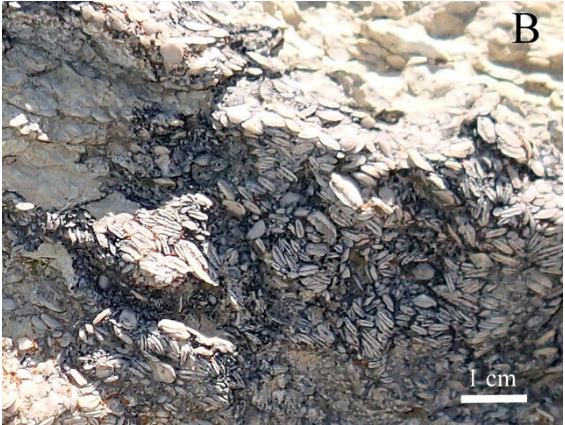
The Prebetic Paleocene-Eocene stratigraphic succession shows a general regressive-transgressive trend. The above-presented results indicate that on the regressive interval of this trend smaller scale RT cycles are superposed.
Cite as: Miclăuș, C., Martín-Martín, M., Tosquella, J., Samsó, J.M. and Tent-Manclús, J.E. (2023): Small scale RT cycles in Lower-Middle Eocene limestones of External Prebetic Units of Betic Cordillera (Alicante Zone). Abstract Book, Fourteenth Romanian Symposium on Palaeontology, Bucharest, 14-15 September 2023 / Zoltán Csiki-Sava, Alina Floroiu, Maria-Raluca Văcărescu, Iuliana Lazăr – Bucureşti : Editura Universităţii din Bucureşti -Bucharest University Press, 2023, 83-84 p.
New biostratigraphic data on the Paleocene-Eocene from the Prebetic
A biostratigraphic study of the Paleocene-Eocene of the stratigraphically continuous with the northern foreland (Iberian Meseta), Prebetic has been studied by using planktonic foraminifera, calcareous nannoplankton, and larger benthic foraminifera. Twelve sections have been studied along the chain: four sections in the Alicante Sector, four in the Murcia Sector, two in the Granada Sector, and two sections in the Jaén Sector.
The Paleocene-Eocene Prebetic succession can be divided into three stratigraphic formations related by lateral and diachronic changes of facies: limestones and calcarenites (rich in larger benthic foraminifera) in middle stratigraphic position, and two marly-clayey formations in lower and upper positions, respectively. The middle unit represents an internal marine platform, while the two marly-clayey represent the external platform (and the upper slope in a few cases). As a whole, above the unconformity, representing the missing interval which includes the Cretaceous-Paleocene boundary.

Cite as: Martín-Martín, M., Miclăuș, C., Serrano, F., Tosquella, J., Samsó, J.M., Tent-Manclús, J.E., and Martín-Pérez, J.A. (2023): New biostratigraphic data on the Paleocene-Eocene succession from the Prebetic domain (Betic Cordillera: South Spain).Abstract Book, Fourteenth Romanian Symposium on Palaeontology, Bucharest, 14-15 September 2023 / Zoltán Csiki-Sava, Alina Floroiu, Maria-Raluca Văcărescu, Iuliana Lazăr – Bucureşti : Editura Universităţii din Bucureşti -Bucharest University Press, 2023, 79-80 p.
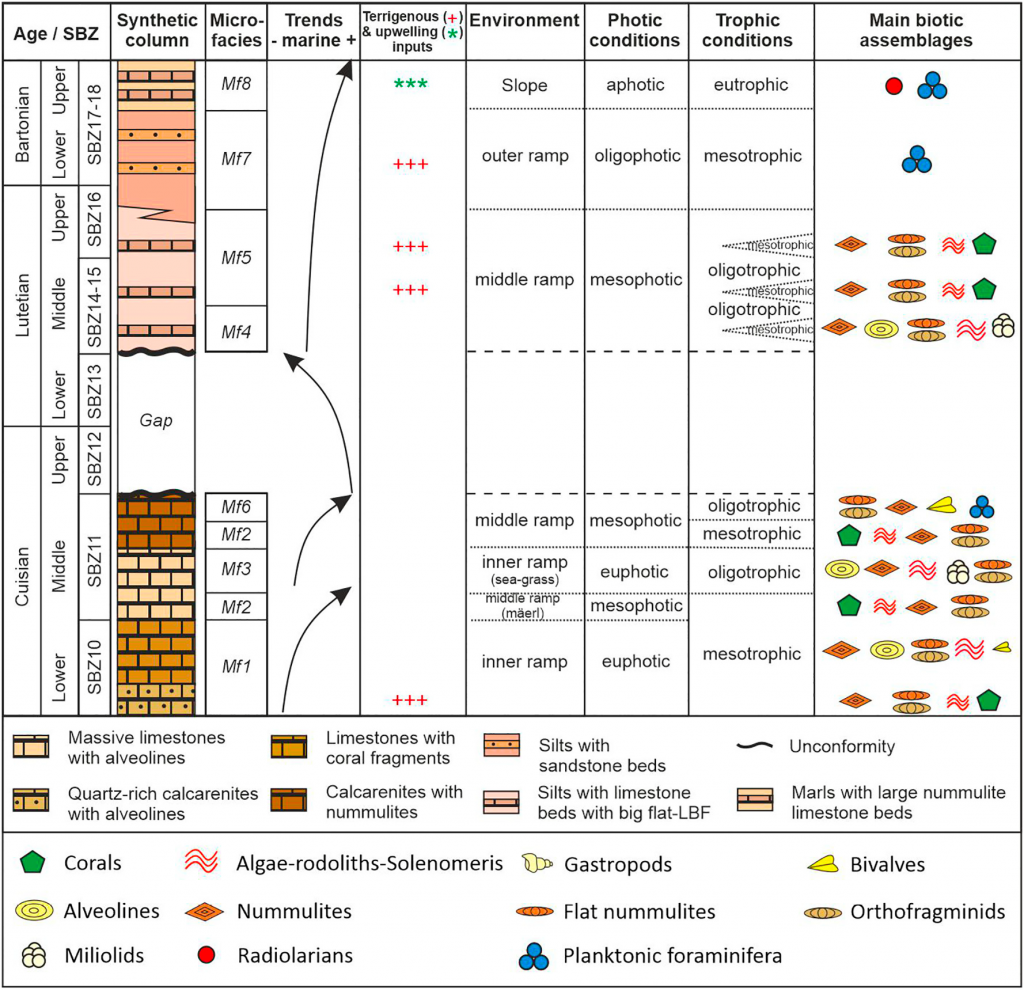
Recent Comments